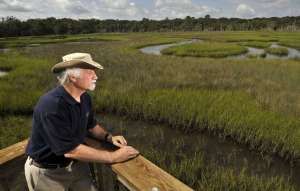
On land, the hungry, miserable French settlers at Fort Caroline were stunned by a "stroke of lightning" that, one wrote, instantly "consumed about 500 acres and burned with such a bright heat that the birds which lived in the meadows were consumed."
The fire burned for three days. The river "seemed almost to boil." Enough fish died to fill 50 carts.
A retired University of North Florida professor thinks the Spanish comet and the French lightning strike were very likely the same thing - an object from outer space that struck at the edge of the St. Johns River in Jacksonville.
It could have been a meteor, asteroid or comet 100 feet across, says UNF's Jay Huebner. Most of it would have vaporized on impact, with trees and animals incinerated in unimaginable heat. Water from the river and marsh would have made a roaring waterfall as it rushed to fill the crater left by the strike.
That crater, Huebner theorizes, is today's Round Marsh in the Timucuan Ecological and Historic Preserve.
It is a strikingly circular marsh, befitting its name, ringed by live oaks and cedars and palms. It forms about three-quarters of a circle, with an open section leading to the marshes that stretch north toward the St. Johns.
Indeed, it's not a big leap of imagination to picture it as a crater, albeit one whose secrets are hidden by water, marsh grasses and centuries of muck.
Huebner is quick to credit the strike theory to the late John Golden, a park ranger at the Timucuan Preserve who was also chief nature trails ranger at UNF. Golden approached him with the idea in the 1990s, when Huebner was teaching a class called The Impact of Asteroids - pun intended, he says.
The professor was intrigued and, along with some colleagues, did some preliminary investigating. But they put it aside as they moved on to other interests.
Now, at 73, Huebner is ready again.
Standing atop a popular birdwatching tower at Round Marsh, he said he needs to find funding for a scientific expedition to solve the mystery of Round Marsh. To start, he's trying to raise $10,000 through crowd-sourcing at petridish.org, a science-oriented site. He's also looking for outside funding.
Huebner is a professor emeritus in UNF's physics department, a teacher since the school's first year of classes in 1972. And he's recruited an informal team of academics from the school to help investigate the marsh.
Finding a crater would be a big deal.
"I'm not a fan of billboards, but imagine the impact of a billboard on I-95 that says there's a meteor impact in Jacksonville," he said.
Barbara Goodman, superintendent of the Timucuan Preserve, said the national park will work with researchers to get them the permits they'd need. "It's a fascinating question," she said. "We're all for finding out whether it's a solid theory or not."
Barry Albright, a UNF geologist and paleontologist, said that taking core samples would be one way to determine if there had been a catastrophic disturbance in 1564.
He didn't want to speculate on it, he said over the phone from southern Utah, where he is searching for evidence of sea life from 93 million years ago.
But he is intrigued by the written accounts from 1564. "There's really circumstantial evidence that indicates that, perhaps, an impact took place," Allbright said.
There is, however, a discrepancy in the texts: The Spanish priest said the comet passed on Aug. 27; the French said the lightning strike came two days later.
Heubner thinks that was because the Spanish, on board their ships, would have had accurate ways to measure the date. The French, who'd gone through turmoil and hunger in their remote outpost, might have lost track of time.
Whatever day it was, the French account called the events of that August day "more worthy of interest and of being recorded than any unusual thing that has yet to come to pass, more strange than historians have written about."
It so befuddled those living there, the French at first thought the native Indians might have burned their houses, out of fear of the French: "It left us in wonderment, because we could not guess where all the fire came from."
The natives, meanwhile, asked what they'd done to offend the French. Why were they firing cannons at them?
Robert "Buzz" Thunen, a UNF archaeologist with extensive experience in Northeast Florida, said first-hand historical accounts can, of course, be exaggerated. And translations of centuries-old documents can be imprecise.
He's not ready to say there's a crater at Round Marsh, though he's happy to be part of the team that would look for it. And it does intrigue him. "At least the way the French presented it, something catastrophic happened," Thunen said.
Huebner admits he'd be disappointed if they investigated the mystery of Round Marsh and came up with nothing. Still, he just wants to know, one way or the other.
"If it's not an impact site, it's important to get the story out that it's not," he said, as a breeze atop the birdwatching tower kept mosquitoes at bay. "It's still a lovely sight."



Reader Comments
to our Newsletter